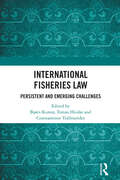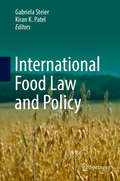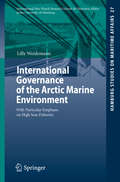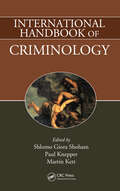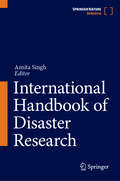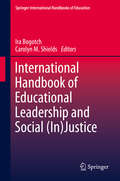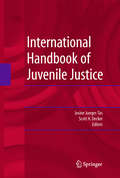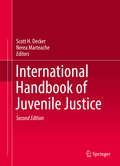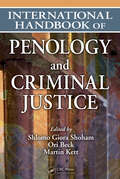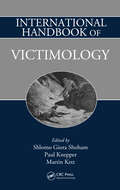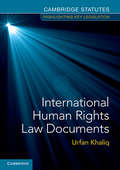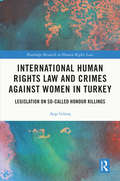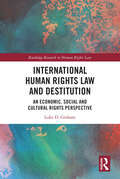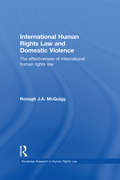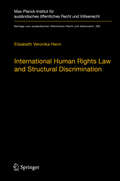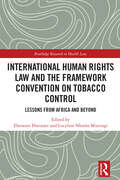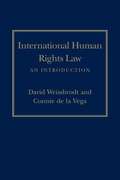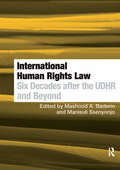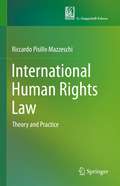- Table View
- List View
International Fisheries Law: Persistent and Emerging Challenges
by Constantinos Yiallourides Bjørn Kunoy Tomas HeidarOffering a practical exploration of persistent and new challenges relating to contemporary international fisheries law, this book examines emerging and unresolved issues in international fisheries law.Covering a wide range of international legal aspects related to fisheries governance, it offers practical perspectives that go beyond the existing debates in this field. An expert team of contributors offers a comprehensive study of current challenges in fisheries governance, institutional law frameworks, procedural aspects and trade and enforcement issues. The book enriches fisheries law scholarship, outlining the capacity of international law to address challenges in international fisheries law and policy, highlighting the critical importance of fisheries to many states, coastal communities and economies globally.The book’s chapters have been meticulously selected, focusing on policy and practical considerations. The result is a comprehensive edited collection covering the main persistent challenges in international fisheries law, making it an essential reading for all those interested in the conservation, integrated management and sustainable use of living resources globally.
International Food Law and Policy
by Gabriela Steier Kiran K. PatelInternational Food Law and Policy is the first interdisciplinary piece of academic literature of its kind with a comprehensive, reader-friendly approach to teaching the major aspects of food regulation, law, policy, food safety and environmental sustainability in a global context The sections are grouped by continents and focus on a range of cross-disciplinary subjects, such as public health, international food trade, the right to food, intellectual property and global regulatory aspects of food production. With its systematic approach, this book will be a valuable resource both for professionals working in food regulation and anyone interested in the subject. It provides a solid foundation for courses and master's programs in environmental management, food law, policy and regulation, and sustainable development around the world.
International Governance and the Rule of Law in China under the Belt and Road Initiative
by Yun ZhaoThe edited volume aims at examining China's role in the field of international governance and the rule of law under the Belt and Road Initiative from a holistic manner. It seeks alternative analytical frameworks that not only take into account legal ideologies and legal ideals, but also local demand, socio-political circumstances, to explain and understand China's legal interactions with countries along the Road, so that more useful insights can be produced in predicting and analysing China's as well as other emerging Asian countries' legal future. Authors from Germany, Korea, Singapore, Mainland China, Taiwan and Hong Kong have contributed to this edited volume, which produces academic dialogues and conducts intellectual exchanges in specific sub-themes.
International Governance of the Arctic Marine Environment
by Lilly WeidemannThe Arctic is particularly affected by climate change; over the past few decades, temperatures in this area have risen twice as fast as the mean global rate. The most prominent effect of global climate change in the region is the melting sea ice in the Arctic Ocean, which enables a multitude of ocean uses to be initiated and extended, such as shipping, fishing and oil and gas extraction. Unlike in the Antarctic, there is currently no single comprehensive legal regime for governance of the Arctic. Instead, the region is regulated by a patchwork of international treaties, above all the United Nations Convention on the Law of the Sea (UNCLOS), various regional and sub-regional agreements, national laws and soft-law agreements. This treatise provides an evaluation of the governance regime that regulates the use of the Arctic marine environment and its readiness to protect these fragile ecosystems in light of the consequences of climate change.
International Handbook of Criminology
by Paul Knepper Shlomo Giora Shoham Martin KettThe second handbook in the Shoham trilogy, which includes the esteemed International Handbook of Penology and Criminal Justice and the upcoming International Handbook of Victimology, this volume is a comprehensive treatment of criminology theory. This text contains contributions from 25 of the top international scholars in the field across a wide range of disciplines. Topics include social deviance, research methods, biological and physiological explanations, personality types, and family socialization processes. The book also explores ecological and economic factors, differential association and situational crime prevention, cultural conflicts and immigration, as well as stigmas, group delinquency and juvenile delinquency.
International Handbook of Disaster Research
by Amita SinghThis handbook is a comprehensive source of information, analysis and directions in disaster studies. It goes beyond the oft-explored issues of management and science related to the topic and explores policies, governance, law and decision-making combined with the processes of implementation and enforcement, all the while integrating the latest science and technology updates related to the topic, such as artificial intelligence and early warning systems. It brings together studies which relate to sociology, politics and institutional economics, which work under the impact of resource availability, issues of leadership and international laws. Disasters are trans-boundary and disaster studies are trans-disciplinary. It is this aspect which would form the fulcrum of contributions and present a new, refreshing and innovative design for the handbook. The transformatory pedagogy which started with the Hyogo Framework for action 2005-2015 and The Sendai Framework for Disaster Risk Reduction 2015-2030 outlines seven clear targets and four priorities for action to prevent new and reduce existing disaster risks. The four priority areas around which the book would revolve are (i) Understanding disaster risk; (ii) Strengthening disaster risk governance to manage disaster risk; (iii) Investing in disaster reduction for resilience and; (iv) Enhancing disaster preparedness for effective response, and to "Build Back Better" in recovery, rehabilitation and reconstruction.
International Handbook of Educational Leadership and Social (In)Justice
by Ira Bogotch Carolyn M. ShieldsThe International Handbook on Educational Leadership and Social (In)Justice creates a first-of-its-kind international forum on conceptualizing the meanings of social justice and leadership, research approaches in studying social justice and combating social injustices, school, university and teacher leadership for social justice, advocacy and advocates for social justice, socio-cultural representations of social injustices, glocal policies, and leadership development as interventions. The Handbook is as much forward-looking as it is a retrospective review of educational research literatures on social justice from a variety of educational subfields including educational leadership, higher education academic networks, special education, health education, teacher education, professional development, policy analyses, and multicultural education. The Handbook celebrates the promises of social justice while providing the educational leadership research community with concrete, contextualized illustrations on how to address inequities and combat social, political and economic injustices through the processes of education in societies and educational institutions around the world.
International Handbook of Juvenile Justice
by Josine Junger-Tas Scott H. DeckerThis comprehensive reference work presents inside information on the Juvenile Justice-systems in 19 different countries, both in old and new EU-member states and in the United States and Canada. The book is the result of research conducted by a group of outstanding researchers, who are concerned about trends in Juvenile Justice in the last two decades, which blur the border between criminal and juvenile justice.
International Handbook of Juvenile Justice
by Scott H. Decker Nerea MarteacheThis comprehensive reference work presents an in-depth analysis of juvenile justice systems across the world. The second edition of this Handbook has been updated with 13 new chapters, now covering a total of 34 countries, across North and South America, Europe, Asia, Africa, and the Middle East from an international and comparative perspective. The International Handbook of Juvenile Justice is the result of research conducted by a group of outstanding scholars working in the field of juvenile justice. It reflects a collective concern about trends in juvenile justice over the past two decades, trends that have begun to blur the difference between criminal and juvenile justice. Also new to the second edition, each chapter is formatted to increase the comparative aspect of the book, highlighting: #65533; The legal status of juveniles #65533; Age of majority #65533; The country's stance toward the UN Committee on the Rights of the Child #65533; Trends in juvenile crime over the period 2004-2014 #65533; Causes of juvenile crime #65533; Policing and juveniles #65533; Courts and juveniles #65533; Custodial rules for juveniles (detention, prison, mixing juveniles with adults) #65533; Alternative sanctions for juveniles: home confinement, restorative justice, restitution, etc. #65533; Differences in treatment of boys and girls This seminal work highlights similarities and differences between the various systems, and will be an important reference for researchers in criminology and criminal justice, particularly interested in juvenile delinquency and youth crime, as well as related disciplines like sociology, social work, and public policy.
International Handbook of Penology and Criminal Justice
by Shlomo Giora Shoham Martin Kett Ori BeckAt the outset of the twenty-first century, more than 9 million people are held in custody in over 200 countries around the world.--from the essay "Prisons and Jails" by Ron KingThe first comparative study of this increasingly integral social subject, International Handbook of Penology and Criminal Justice provides a comprehensive and balanced revie
International Handbook of Victimology
by Paul Knepper Shlomo Giora Shoham Martin KettIn the nearly four decades since the First International Symposium on Victimology convened in Jerusalem in 1973, some concepts and themes have continued to hold a prominent place in the literature, while new ones have also emerged. Exploring enduring topics such as conceptions of victimhood, secondary and hidden victimization, and social services f
International Housing Market Experience and Implications for China (Routledge Studies in International Real Estate)
by Bertrand Renaud Rebecca L. Chiu Zhi LiuRecent rapid housing market expansion in China is presenting new challenges for policy makers, planners, business people, and citizens. Now that housing in middle-income China is driven by consumer choices and is no longer dominated by state policy decisions, housing policy issues in Chinese cities are becoming increasingly similar to those encountered in other global housing markets. With soaring prices and imbalances in housing supply favoring high income groups and housing demand driven by rising inequality in household incomes, many middle and lower-income households face worsening choices in terms of the quality and location of their housing as well as greater financial difficulties, which together can have negative implications for standards of public health. This book examines the impact of these changes on the general population, as well as on aspiring homeowners and developers. The contributors look at the effect on the widening of wealth gaps, slower economic growth, and threats to political and social stability. Though focusing on China, the editors also present discussions of specific policy design challenges encountered in Australia, Japan, Korea, the Netherlands, the Nordic countries, Singapore, Taiwan, the UK, and the US. This book would be of interest to housing policy makers, as well as academics who are studying the social and political effects of the Chinese housing market.
International Human Rights Law Beyond State Territorial Control (Cambridge Studies in International and Comparative Law)
by Antal BerkesCan international human rights law be applied and enforced in a part of a State's territory outside its effective control? This study provides a step by step analysis to show how it can. International human rights law can normalise an imperfect, defective situation through pragmatic interpretation; it imposes obligations both on the territorial State on account of its sovereign title and residual effectiveness on the one hand, and on any subject of international law exercising territorial control over the area on account of its effective control on the other. By considering effectiveness beyond formal normative sources and titles of the subjects implicated in the territorial situation, international human rights law is interpreted and applied in a manner which renders human rights practical and effective. The book provides a comprehensive analysis of State practice regarding various subjects implicated in the territorial situation, applicable legal sources and major geographic areas.
International Human Rights Law Documents
by Urfan KhaliqThis accessible collection of important international human rights documents is an essential resource for students and researchers of international human rights law. In addition to standard instruments such as the Universal Declaration, the 1966 United Nations Covenants and the European Convention and its Protocols, the volume also features topics and documents such as all core UN human rights treaties and their protocols, key international labour instruments and the obligations of the global financial organisations and multi-national corporations. Taking a broad and historical approach, the collection also incorporates Inter-American, African, Asian and Arab instruments alongside older UN documents and numerous soft law documents. Its approach reflects the diverse nature of international human rights law and the courses which now seek to teach it. This book is also valuable for students of international law, global governance and other courses which discuss the law of international human rights.
International Human Rights Law and Crimes Against Women in Turkey: Legislation on So-Called Honour Killings (Routledge Research in Human Rights Law)
by Ayşe GüneşThis book evaluates the effectiveness of current international human rights law, and in particular the recent Istanbul Convention, in eradicating so-called honour killings in Turkey. So-called ‘honour killings’ have become an issue of concern for the international community. In Turkey, in particular, the practice still exists despite the adoption of the relevant human rights instruments. The book argues that the improvement of the status of women in Turkey in accordance with gender equality as well as the application of the principle of state due diligence, both requirements of the Istanbul Convention and international human rights law, are fundamental means towards eradicating the killing of women in the name of ‘honour’. Using feminist approaches, in particular the intersectionality approach, the study looks at the application of such standards as well as the current obstacles. Through such a lens, the study discusses the strengths and weaknesses of the Turkish Constitution, Turkish Civil Code, Turkish Penal Code and Law to Protect Family and Prevent Violence Against Women and questions the judicial approach to the implementation of the women’s right to life. It identifies the lacunae in the Turkish legislation that allow inadequate legal protection for women and the inconsistency of the judicial approach to the definition of the so-called honour killings in the judgements. The study then recommends some concrete amendments to the relevant legal provisions in order to better reflect the international framework and the feminist approaches. The book will be a valuable resource for academics, researchers and policy-makers in the areas of international human rights law and feminist legal theory.
International Human Rights Law and Destitution: An Economic, Social and Cultural Rights Perspective (Routledge Research in Human Rights Law)
by Luke D. GrahamThis book explores destitution from the perspective of International Human Rights Law and, more specifically, Economic, Social and Cultural Rights. The experience of destitution correlates to the non-realisation of a range of economic, social and cultural rights. However, destitution has not been defined from this perspective. Consequently, the nexus between destitution and the denial of economic, social and cultural rights remains unrecognised within academia and policy and practice. This book expressly addresses this issue and in so doing renders the nexus between destitution and the non-realisation of these rights visible. The book proposes a new human-rights-based definition of destitution, composed of two parts. The rights which must be realised– the component rights – and the level of realisation of these rights which must be met – the destitution threshold – to avoid destitution. This human rights-based understanding of destitution is then applied to a UK case study to highlight the relationship between government policy and destitution, to illustrate how destitution manifests itself, and to make recommendations – founded upon engendering the realisation of economic, social and cultural rights – aimed towards addressing destitution. This book will have global and cross-sectoral appeal to anti-poverty advocates, policy makers, as well as to researchers, academics and students in the fields of human rights law, poverty studies, and social policy.
International Human Rights Law and Domestic Violence: The Effectiveness of International Human Rights Law (Routledge Research in Human Rights Law)
by Ronagh J.A. McQuiggThis innovative book examines the effectiveness of international human rights law, through the case study of domestic violence. Domestic violence is an issue that affects vast numbers of women throughout all nations of the world, but as it takes place between private individuals it does not come within the ambit of the traditional interpretation of human rights law. Ronagh J.A. McQuigg questions whether international human rights law can only be effective in a ‘traditional’ case of human rights abuse or whether it can rise to the challenge of being used in relation to issues such as domestic violence. The book focuses primarily on the question of how international human rights law could be used in relation to domestic violence in the United Kingdom. McQuigg considers recent case law from the European Court of Human Rights on domestic violence and whether the UK courts could use the Human Rights Act 1998 to assist victims of domestic violence. The book goes on to look in detail at the statements of the international human rights bodies on domestic violence, with particular focus on those made by the United Nations Committee on the Elimination of Discrimination against Women and the Special Rapporteur on Violence against Women. The book explores the impact that the statements have had so far on the UK government’s policy in relation to domestic violence and discusses how the statements made by the international human rights bodies could be used more effectively by non-governmental organisations, such as human rights groups and women’s groups.
International Human Rights Law and Practice
by Ilias Bantekas Lutz OetteHuman rights law is a complex but compelling subject that fascinates students but also confuses them. This innovative textbook explores human rights law from a theoretical and practical perspective. Case studies and interviews with specialist practitioners, NGO activists and policy-makers show how theory is applied in real life. The up-to-date coverage includes introductions to important emerging fields such as globalisation, poverty and advocacy. Student learning is supported by questions to stimulate seminar discussion and further reading sections that encourage independent study. The authors' combined expertise, engaging writing style and ability to clarify not simplify ensures that this important new book will become required reading for all students of human rights law.
International Human Rights Law and Practice
by Ilias Bantekas Lutz OetteHuman rights law is a complex but compelling subject that fascinates students but also confuses them. This innovative textbook explores human rights law from a theoretical and practical perspective. Case studies and interviews with specialist practitioners, NGO activists and policy-makers show how theory is applied in real life. The up-to-date coverage includes introductions to important emerging fields such as globalisation, poverty and advocacy. Student learning is supported by questions to stimulate seminar discussion and further reading sections that encourage independent study. The authors' combined expertise, engaging writing style and ability to clarify not simplify ensures that this important new book will become required reading for all students of human rights law.
International Human Rights Law and Protection Against Gender-Based Harm on the Internet
by Maria SjöholmThis book analyses gender-based offences on the Internet from the perspective of international human rights law, interwoven with rights theories and feminist legal theories. It investigates whether international human rights law is applicable in regulating harmful online conduct and speech, with a focus on sexual violence, various forms of harassment, sexist hate speech and harmful pornography. This involves assessing whether gender-based online offences are considered violations of international human rights law and – if they are recognised as such explicitly or by way of interpretation – the extent of state obligations. The book reviews a range of international law sources, such as selected international human rights law treaties, case law, soft-law documents and academic scholarship. The application of general human rights law provisions to the online sphere is evaluated by considering the online/offline coherence of provisions as well as potential gaps, inconsistencies and disadvantages that exist in the regulation of online gender-based offences. The makeup, aim and effect of social spheres, areas of law and legal principles are thus assessed in relation to gender and the Internet. Aspects discussed include the architecture of the Internet, the structure of public international law, the harm principle as employed in domestic law and international human rights law, and the scope of particular rights, mainly involving the freedom of expression and the right to privacy. Working from the premise that the transposition of international human rights law to the Internet must ensure the former’s functionality and effectiveness, the book argues that a contextual application of rights is called for. This requires assessing what is harmful online – including the effects of online speech and conduct - and what are effective means of regulating liability on the Internet. In turn, such assessments require a gender-sensitive approach.
International Human Rights Law and Structural Discrimination: The Example of Violence against Women (Beiträge zum ausländischen öffentlichen Recht und Völkerrecht #280)
by Elisabeth Veronika HennInternational courts and other actors are increasingly taking into account pre-existing social structures and inequalities when addressing and redressing human rights violations, in particular discrimination against specific groups. To date, however, academic legal research has paid little attention to this gentle turn in international human rights law and practice to address structural discrimination. In order to address this gap, this study analyses whether and to what extent international and regional human rights frameworks foresee positive obligations for State parties to address structural discrimination, and, more precisely, gender hierarchies and stereotypes as root causes of gender-based violence. In order to answer this question, the book analyses whether or not international human rights law requires pursuing a root-cause-sensitive and transformative approach to structural discrimination against women in general and to the prevention, protection and reparation of violence against women in particular; to what extent international courts and (quasi)judicial bodies address State responsibility for the systemic occurrence of violence against women and its underlying root causes; whether or not international courts and monitoring bodies have suitable tools for addressing structural discrimination within the society of a contracting party; and the limits to a transformative approach.
International Human Rights Law and the Framework Convention on Tobacco Control: Lessons from Africa and Beyond (Routledge Research in Health Law)
by Ebenezer Durojaye Lucyline Nkatha MurungiThis book reviews the challenges and opportunities in the implementation of the WHO Framework Convention on Tobacco Control (FCTC) at the regional and national levels in Africa. It contains an analysis of the relevant norms and monitoring mechanisms at the regional level, and case studies from selected African and other developing countries. The WHO has noted that tobacco use or exposure to tobacco is a major health risk factor for non-communicable diseases (NCDs). This volume highlights the importance of taking measures to control tobacco use in Africa with a view to preventing these risks. With contributions from experts from the Global South, the book provides a critical analysis of the role that human rights can play in mitigating the impact of tobacco use and NCDs, and the implementation of the FCTC. The book contains a systematic and in-depth analysis of how efforts to realise the right to health under international and regional law can help to address the incidence of tobacco use in the developing world. The collection will be an important resource for academics, researchers and policymakers working in the areas of public health law and international human rights.
International Human Rights Law: An Introduction
by David Weissbrodt Constance de la Vega"International Human Rights Law" is a comprehensive introductory treatise, intended for all concerned about this critical area of international law, including students, lawyers, other advocates, teachers, and academics.
International Human Rights Law: Six Decades after the UDHR and Beyond (Oxford Monographs In International Law Ser.)
by Manisuli SsenyonjoThis timely and valuable book explores the development of international human rights law over the last six decades. The volume brings together leading experts to reflect on different aspects of human rights law, not only considering and evaluating the developments so far, but also identifying relevant problems and proposing relevant possible perspectives for the continued positive future development of human rights law. The book is international in perspective, both in scope and context, and covers developments in the international protection of human rights since the adoption of the UDHR in 1948. The developments considered include the United Nations system of protecting human rights as well as regional human rights systems in Africa, America and Europe. It also considers some key themes relevant to human rights including globalisation, protecting human rights in emergency situations and trade sanctions, the development of human rights NGOs, and many others. The book will be an invaluable resource for students, academics and policy-makers working in the field of international human rights.
International Human Rights Law: Theory and Practice
by Riccardo Pisillo MazzeschiThis textbook provides a thorough and systematic overview of human rights law, including the most relevant practice and case law, but also dealing with theoretical issues. It pursues an original approach, seeking to reconcile its didactic purpose with a scientific one, positing that there must be a necessary synergy between these two purposes. Furthermore, the author is convinced that international human rights law should not be studied (as is done in virtually every textbook) as a special legal regime, separate and autonomous from the overall system of international law; but as a regime that is fully integrated into the international legal order. The book’s dominant theme is the interrelationship of international human rights law and general international law. Following this approach, the author has chosen to devote comparatively little content to institutional issues (Part IV) and to instead more intensively explore the structural impact of human rights law on the entire international order (Part I); on the sources (Part II) and obligations (Part III) of general international law; and what constitutes “fundamental” human rights (Part V), without neglecting other rights (Part VI).
